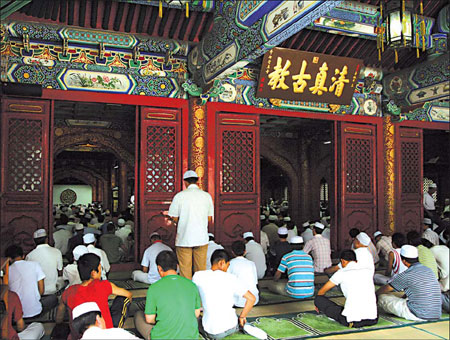 |
|
Muslims attend a Jum'ah or Friday prayer at the Niujie Mosque in Beijing. |
A well-known Hadith or saying attributed to the Prophet Muhammed says: 'Seek knowledge, even if you have to go to China for it.' Abiding by these words, the third Caliph Uthman Ibn Affan sent an envoy to the Tang Dynasty (AD 618-907) in 651. Chinese scholars regard this as the introduction of Islam into China.
Today, 2,357 years later, believers coming to China can pray side by side with Chinese Muslims at Beijing's Niujie Mosque, one of 12 mosques specially designated to serve foreign Muslims during the Olympic Games. The Number 10 bus, which stops at Niujie Mosque, even announces station names in Arabic.
Since July, young Arabic and English speaking volunteers for the Beijing Olympics have been busily serving as guides for the increasing number of visitors to the city's most famous and oldest mosque, which is located on Niujie, or 'Ox Street'.
'I'm not going home to Xinjiang this summer vacation, ' said Yang Zhixue, a third-year student at the China Islamic Institute who is one of the young volunteers at Niujie Mosque. 'Although I miss home, I feel really lucky to have this opportunity to contribute to the Olympic effort.'
Ma Yanbing, a 36-year-old imam at the Niujie Mosque, said that the Olympic Games have been a topic of his sermons.
'The Olympic Games advocate peace and friendship, and so does Islam,' he said. 'We should let the world know about Chinese Muslims during the Beijing Olympic Games, and make friends with Muslims and non-Muslims from around the world.'
The mosque took a number of measures in preparation for the Olympics, including new carpeting, English-language signs, and providing long trousers and long skirts to visitors who are not properly dressed to enter the mosque, according to Niujie Mosque's deputy director Wei Chunjie.
Although all 72 mosques in Beijing are open to foreign visitors, the 12 designated mosques for the Olympics were chosen for their convenient locations, according to the Beijing Islamic Association. Besides Niujie Mosque, Dongsi Mosque and Huashi Mosque were also chosen.
Historical records show that the Arabian scholar Nasurutan built Niujie Mosque in 996. The tombstones of two foreign Muslims in the mosque are testimony to its long history: that of Ahmed Burdani from Ghaznavid in today's Afghanistan, who died in 1280, and of Ali Imad al Din from Bukhara in today's Uzbekistan, who died in 1283. Both preached in Niujie Mosque and died in Beijing.
Unlike mosques in the Middle East, Chinese mosques, especially those in Beijing, are often built in Chinese architectural style. For example, the Dongsi Mosque consists of three connected quadrangles. The roofs of the different buildings of the mosque are like those of Chinese temples, while the minaret is in Chinese pavilion style.
Other mosques in Beijing have a blended Chinese and Arabic architectural style, such as Andingmen Mosque in the Dongcheng District.
"The architectural styles of mosques in China are the result of cultural exchanges between China and the Arabic countries," according to Feng Jinyuan, a researcher with the Institute of World Religions of the Chinese Academy of Social Sciences.
Of Beijing's 72 mosques, 29 are in the urban districts and 43 in the outlying areas. There are an estimated 250,000 Muslims in the Beijing area. Most are of the Hui minority. The most important mosques in Beijing, such as Niujie, Madian, and Huashi, are located in major Hui minority communities.
According to the Beijing Islamic Association, there were 146 mosques in Beijing prior to 1958. However, during the 'anti-rightist' movement in the late 1950s, most of the mosques were closed. During the 'cultural revolution' (1966-76), only the Dongsi Mosque was left open for foreigners.
All religious activity was regarded as the 'four olds' - old thoughts, old culture, old customs, and old habits - and suppressed. At the Niujie Mosque, broken stone tablets serve as testament to the extreme actions taken against Islam during that time.
It was after 1978 that Islam began to be revived in China, along with other religions. In the 1980s, mosques were rebuilt and re-opened. Training of imams resumed, not only in mosques, but also in newly established Islamic institutes throughout China.
However, an entire generation was lost to training because of an interruption of nearly three decades. Of today's 140 imams in Beijing, apart from a few who are over 70, most are between their early twenties to late forties.
Forty-six-year-old Liu Kejie, vice-president of the Beijing Islamic Association and an imam at the Dongsi Mosque, was one of the first imams trained after the "cultural revolution". He was among the first class of graduates from the Beijing Islamic Institute in 1987.
'As opposed to older imams who received a traditional Islamic education in mosques, today's young imams are mostly graduates from formal Islamic institutes,' he said. 'Young imams might not be as advanced in religious studies as the older generation, but we usually have a wider perspective and are good at relating to modern life in our preaching.'
On May 16, at the first Jum'ah or Friday prayer after the May 12 earthquake in Sichuan, Liu gave a sermon on what Muslims should do during a calamity and called on fellow Muslims to donate money to help the quake-stricken area.
Although Islam first landed in China's southern cities of Quanzhou and Guangzhou, it grew substantially in Beijing after the city became the capital of the Yuan Dynasty (1271-1368).
When Genghis Khan took his army westward, he captured many Arabic, Persian, and Central Asian peoples and brought them to China. These people stayed in China, and intermarried with the Han and Mongolian people. Their descendents became today's Hui ethnic minority.
|

|
|
The Niujie Mosque is built in Chinese architectural style. Wang Jing |
(China Daily August 15, 2008)